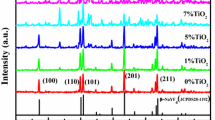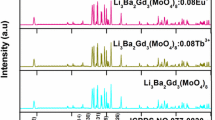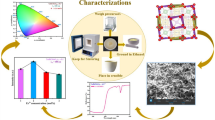Abstract
NIR and visible emission have been reported from Tb3+, Nd3+ and Yb3+ doped La2O3. XRD, TEM and HRTEM corroborate good crystallinity of the nano-phosphor. The average particle size is around 15 nm examined via TEM and HRTEM. The photoluminescence up-conversion spectra of Tb3+ and Yb3+ co-doped La2O3 exhibited characteristic emission peaks of Tb3+ ion at 480, 544 and 610 nm. It is possible due to the absorption of two 980 nm pump photons by Tb3+ ion via Yb3+ sensitizer. The energy migration from Tb3+ to Nd3+ takes place so that the intensity of 820 nm (4F5/2, 2H9/2 → 4I9/2) is increased significantly. The energy transfer between these two ions reduces the intensity of 544 nm Tb3+ ion whereas the intensity of 820 nm improved. Energy transfer mechanism between Tb3+, Nd3+ and Yb3+ ions has been discussed in detail. It would be a promising candidate for solar cells and biomedical applications.
Similar content being viewed by others
Avoid common mistakes on your manuscript.
1 Introduction
The maximum loss in solar cells occurs due to the passage of lower energy photon through it without creating an electron–hole pair (exciton) and also due to the high energy photons which cause thermal loss at the junction [1]. Lanthanide activated phosphors garnered much attention because these convert energy from higher to lower unit and vice versa [2,3,4,5]. Solar cells are divided into various categories namely c-Si, amorphous solar cells, dye-sensitized and organic–inorganic solar cells and their band gap is found in the range 1.1–1.8 eV (~ 650 to 1100 nm). It is previously reported that Nd3+, Tb3+, Ce3+, Eu3+, Tm3+ co-doped with Yb3+ ion gives emission around ~ 800 to 1000 nm via ultra-violet or visible excitation [3,4,5,6,7]. However, recent researches are focused on the development of such type of phosphor materials which significantly absorb infrared and UV–visible radiation. These absorbed radiations are converted into the radiations comparable to the solar cell band gap. Nd3+ ion would absorb UV–visible as well as NIR photons and it could be sensitized through Yb3+ ion [4, 8]. Additionally, Yb3+ co-doped Tb3+ also gives up-conversion (UC) green emission [9]. Prorok et al. [10] reported energy migration up-conversion from Tb3+ to Yb3+ and Nd3+ co-doped fluoride core–shell structure. La2O3 is a promising host for rare-earth doping because it has low phonon energy which significantly reduces the possibility of non-radiative (NR) transitions [11]. Also, it is compatible with other fluorescent lanthanides which also reduce the possibility of non-radiative transitions. Chen et al. [12] reported LiYF4: Yb3+, Er3+ single crystal to improve the power conversion efficiency of perovskite solar cell. Here, we report photoluminescence (PL) UC-emission by Tb3+, Yb3+ and Nd3+ co-doped La2O3. The samples were synthesized by the polyol method. The NIR emission intensity of 820 nm (Nd3+ ion) might be improved due to energy migration from Tb3+ and Yb3+ ions.
2 Experimental method
La2O3 (99.9%), Tb2O3 (99.98%), Yb2O3 (99.995%) were purchased from Alfa Aesar. Nd2O3 (99.9%), ethylene glycol, urea and HNO3 (69%) were purchased from Merck. La(NO3)3, Tb(NO3)3, Nd(NO3)3 and Yb(NO3)3 were prepared by dissolving their respective oxides in de-ionized water with the addition of few drops of HNO3. The nitrate was mixed by taking the solution of La(NO3)3, Tb(NO3)3 Yb(NO3)3 and Nd(NO3)3 in a volumetric flask. Another solution was prepared by dissolving 4 g urea in 25 ml ethylene glycol (pH around 8–9). This solution is added to the rare earth nitrate solution kept at continuous stirring at the temperature of 120 °C for 4 h to complete the precipitation. The precipitate obtained was washed with de-ionized water and methanol and then dried it at 80 °C. Finally, the sample was calcined at 800 °C for the phase formation of La2O3. The structural analysis was characterized by using D8 Bruker X-ray diffractometer (XRD) with Ni-filtered Cu-Kα (1.5405 Å) radiation (10° < 2θ < 80° with a step size of 0.02°). The morphology of particles was determined by using the transmission electron microscope (TECNAI G2, 300 keV). The up-conversion spectra were recorded by exciting with diode laser 980 nm (CW, 1 W) using an iHR320 Jobin–Yvon spectrometer equipped with R928 photomultiplier tube. The PL decay measurement for a 544 nm emission band was performed with a 980 nm diode source. The collected signal was interfaced to a 150 MHz digital oscilloscope (model no. HM 1507, Hameg Instruments).
3 Results and discussion
Figure 1a shows XRD pattern of La2O3: 1%Tb, 10%Yb, x % Nd (x = 5, 10 at%) nanoparticles. All the diffraction peaks match with JCPDS 65-3185 reflecting the cubic phase (space group Ia\(\bar{3}\)) of La2O3 (a = 11.42 Å and V = 1489.36 Å3). Absence of impurity phases corroborates successful substitution of La3+ with Tb3+, Nd3+ and Yb3+ ions. However, a diffraction peak splits into two parts in which a peak mark by * at 27.96° obtained due to the formation of La2O3 cubic structure and space group Im\(\bar{3}\)m from JCPDS card number 89-4016. The broadness of the peaks shows the formation of nano-particle with good crystallinity. The crystalline size was lies in the range 6–8 nm which was calculated by Scherrer formula. Moreover, the morphology and size of the particles is determined by SEM and TEM which is shown in Fig. 1b, c. The particles are spherical in shape, uniformly distributed and exhibit particle size of around 8–26 nm. In addition, the particle size distribution plot is shown in the inset of Fig. 1c. The average particle size estimated from Gaussian fitting is 15 nm. The corresponding high-resolution TEM (HRTEM) is given in Fig. 1d. It is indexed according to JCPDS file representing (125) and (600) planes of La2O3. There are no defects or absence of grain boundaries found in HRTEM.
PL emission spectra recorded under 980 nm excitation of Tb3+ and Yb3+ co-doped La2O3 shows emission peaks of Tb3+ at 544 (5D4 → 7F5), 610 nm (5D4 → 7F3) shown in Fig. 2 [2]. The dominant intensity was observed for 544 nm emission. Nd3+ co-doped La2O3 exhibits Tb3+ as well as Nd3+ emission peaks. The emission peaks are centered at 760 and 820 nm observed due to 4S3/2 → 4I9/2 and 4F5/2, 2H9/2 → 4I9/2 transitions, respectively [8, 13, 14]. From PL emission spectra it is clearly shown that the intensity of 820 nm emission increases with increasing Nd3+ concentration. However, from the inset of Fig. 2, it can be interpreted that the intensity of 544 nm emission decreases with increasing Nd3+ concentration. It might be due to the energy migration from Tb3+ ion to Nd3+ ion so that the intensity of 820 nm would improve. Yb3+ also transfers its energy to Nd3+ so that UC emission is possible from the sample. However, the intensity of other peaks of Tb3+ ion is not much affected by Nd3+ doping. Tb3+ ion also gives emission with UV-excitation and it transfers its absorbed energy to Nd3+ ion. So present phosphor also able to reduce heating loss from solar cell junction because could absorb UV-radiation and convert into NIR radiation (820 nm) comparable to the solar cell band gap. Moreover, if the number of photons absorbed by solar cells increases than the efficiency of solar cells obviously increases.
The number of photons involved in the emission process is calculated by using the relation I α Pn where I is the integrated area, P is pumped laser power and n is the number of significant photons involved for single-photon emission [15]. Figure 3a, b represents power-dependent emission spectra and ln(I) versus ln (P) plot for of La2O3: 1% Tb3+, 10% Yb3+, 5% Nd3+. The slope of the logarithmic graph indicates the number of significant photons involved for 543 and 820 nm emission. It is 1.03 for Nd3+ ions 820 nm emission and 1.47 for Tb3+ ions 544 nm emission. Nearly two photons are absorbed by Tb3+ ion for green emission whereas only one photon is needed for 820 nm emission [16, 17]. Tb3+ ion gets excited via absorbing a 980 nm pump photon by excited-state absorption or energy transfer UC process through Yb3+ sensitizer. However, Nd3+ absorbs energy from Tb3+ ion (5D4 state) and gets excited to 4S3/2/4F5/2/2H9/2 state then relaxes to ground state (4I9/2) by emitting visible and NIR photons.
Figure 4 illustrates schematic energy level diagram for energy transfer (ET) between Tb3+, Nd3+ and Yb3+ ions. When 980 nm photon incidents on the sample, Yb3+ absorbs that photon and get excited to 5F5/2 state. Yb3+ absorbs another 980 nm photon in its excited state (5F5/2) and get populate to its virtual excited state. The energy of Yb3+ ions virtual excited state is approximately equal to the energy of the 5D4 state of Tb3+ ion. Therefore, Tb3+ ions electrons get excited to 5D4 state by co-operative energy transfer (CET) then relaxe to the ground by emitting visible photons. Meanwhile, Tb3+ also transfers its energy to Nd3+ ion by back energy transfer (BET) which is supported from PL emission spectra given in inset of Fig. 2 [10, 18]. Moreover, some electrons excite from excited-state absorption (ESA) to 2G9/2 state in Nd3+ and electrons transit from this state to 4F5/2 NR relaxation. Simultaneously, energy transfer between 5F5/2 (Yb3+) and 4F5/2/4F3/2 (Nd3+) also takes place so that more electron gets populated in 4F5/2 state of Nd3+ ion. Then it relaxes to the ground state by an emitting photon of 820 nm radiation.
The lifetime of the sample has been measured for 544 nm emission and 980 nm excitation wavelength. The decay profile is shown in Fig. 5 for Tb3+–Yb3+ and Nd3+ co-doped sample. The decay time estimated by the mono-exponential fitting equation I = I0 e− t/τ1, where I0 is the initial intensity and τ is the lifetime. Here, lifetime values observed from mono-exponential fitting are 0.42, 0.34 and 0.23 ms for La2O3:1%Tb3+, 10%Yb3+, La2O3:1%Tb3+, 10%Yb3, 5%Nd3+ and La2O3:1%Tb3+, 10%Yb3, 10%Nd3+. The energy transfer efficiency from Tb3+ ion to Nd3+ was calculated by using the following equation:
where η is energy transfer efficiency from Tb3+ ion to Nd3+ ion, τ is the lifetime in presence of acceptor Nd3+ ion, \(\tau_{0}\) an average lifetime of sensitizer (Tb3+ ion). From this equation maximum transfer efficiency observed for La2O3:1%Tb3+, 10%Yb3, 10%Nd3+ is 45.6% which represents that Tb3+ efficiently transfer energy to Nd3+ ion.
4 Conclusions
Tb3+, Nd3+ and Yb3+ doped exhibiting cubic structure have been successfully synthesized. UC PL emission spectra indicate improvement in emission intensity of 820 nm of Nd3+ ion due to absorption of energy from both Yb3+ and Tb3+ ions. The enhancement is observed due to migration of energy between lanthanides. Moreover, reduction in intensity of 544 nm confirms energy transfer from Tb3+ to Nd3+ ion. These studied reveals that Yb3+ co-doping improves up-conversion performance of nano-phosphors. Tb3+ also transfers its energy to Nd3+ ion so its emission would significantly improve which is beneficial for improving solar cell efficiency.
References
Ramasamy P, Manivasakan P, Kim J (2014) Upconversion nanophosphors for solar cell applications. RSC Adv 4:34873–34895
Jain N, Singh BP, Singh RK, Singh J, Singh RA (2017) Enhanced photoluminescence behaviour of Eu3+ activated ZnMoO4 nanophosphors via Tb3+ co-doping for light emitting diode. J Lumin 188:504–513
Singh BP, Singh J, Singh RA (2014) Luminescence properties of Eu3+-activated SrWO4 nanophosphors-concentration and annealing effect. RSC Adv 4:32605–32621
Song D, Guo C, Zhao J, Suo H, Zhao X, Zhou X, Liu G (2016) Host sensitized near-infrared emission in Nd3+–Yb3+ Co-doped Na2GdMg2V3O12 phosphor. Ceram Int 42:12988–12994
Terra IAA, Borrero-González LJ, Figueredo TR, Almeida JMP, Hernandes AC, Nunes LAO, Malta OL (2012) Down-conversion process in Tb3+–Yb3+ co-doped Calibo glasses. J Lumin 132:1678–1682
Li J, Chen L, Hao Z, Zhang X, Zhang L, Luo Y, Zhang J (2015) Efficient near-infrared downconversion and energy transfer mechanism of Ce3+/Yb3+ codoped calcium scandate phosphor. Inorg Chem 54:4806–4810
Yu T, Lin H, Yu D, Ye S, Zhang Q (2015) Energy transfer dynamics and quantum Yield derivation of the Tm3+ concentration-dependent, three-photon near-infrared quantum cutting in La2BaZnO5. J Phys Chem C 119:26643–26651
Sun J, Sun Y, Cao C, Xia Z, Du H (2013) Near-infrared luminescence and quantum cutting mechanism in CaWO4:Nd3+, Yb3+. Appl Phys B 111:367–371
Dong H, Sun L, Wang Y, Xiao J, Tu D, Chen X, Yan C (2016) Photon upconversion in Yb3+–Tb3+ and Yb3+–Eu3+ activated core/shell nanoparticles with dual-band excitation. J Mater Chem C 4:4186–4192
Prorok K, Pawlyta M, Strek W, Bednarkiewicz A (2016) Energy migration up-conversion of Tb3+ in Yb3+ and Nd3+ codoped active-core/active-shell colloidal nanoparticles. Chem Mater 28:2295–2300
Xu Z, Bian S, Wang J, Liu T, Wang L, Gao Y (2013) Preparation and luminescence of La2O3:Ln3+ (Ln3+ = Eu3+, Tb3+, Dy3+, Sm3+, Er3+, Ho3+, Tm3+, Yb3+/Er3+, Yb3+/Ho3+) microspheres. RSC Adv 3:1410–1419
Chen X, Xu W, Song H, Chen C, Xia H, Zhu Y, Zhou D, Cui S, Dai Q, Zhang J (2016) Highly efficient LiYF4:Yb3+, Er3+ upconversion single crystal under solar cell spectrum excitation and photovoltaic application. ACS Appl Mater Interfaces 8:9071–9079
Marciniak L, Bednarkiewicz A, Drabik J, Trejgis K, Strk W (2017) Optimization of highly sensitive YAG: Cr3+, Nd3+ nanocrystal-based luminescent thermometer operating in an optical window of biological tissues. PCCP 19:7343–7351
Marciniak L, Bednarkiewicz A, Stefanski M, Tomala R, Hreniak D, Strek W (2015) Near infrared absorbing near infrared emitting highly-sensitive luminescent nanothermometer based on Nd3+ to Yb3+ energy transfer. Phys Chem Chem Phys 17:24315–24321
Singh BP, Parchur AK, Singh RK, Ansari AA, Singh P, Rai SB (2013) Structural and up-conversion properties of Er3+ and Yb3+ co-doped Y2Ti2O7 phosphors. Phys Chem Chem Phys 15:3480–3489
Pandey A, Rai VK, Kumar V, Kumar V, Swart HC (2015) Upconversion based temperature sensing ability of Er3+–Yb3+ codoped SrWO4: an optical heating phosphor. Sens Actuators B 209:352–358
Hu F, Wei X, Qin Y, Jiang S, Li X, Zhou S, Chen Y, Duan CK, Yin M (2016) Yb3+/Tb3+ co-doped GdPO4 transparent magnetic glass-ceramics for spectral conversion. J Alloys Compd 674:162–167
Deshmukh P, Satapathy S, Ahlawat A, Tiwari MK, Karnal AK (2018) Fabrication and characterization of Er, Nd codoped Y2O3 transparent ceramic: a dual mode photoluminescence emitter. J Alloys Compd 754:32–38
Acknowledgements
Authors are thankful to Sophisticated Instrument centre of the University for providing various characterization facilities. We are also thankful to Prof. S.B. Rai for providing PL facility. Neha Jain acknowledges the Maulana Azad National Fellowship provided by University Grants Commission (UGC), Govt. of India. Jai Singh would like to acknowledge UGC-India and DST for providing project under UGC Start-up Grant FT30 [HYPHEN]56/2014 (BSR)3(A)a and DST Fast track Grant No. SR/FTP/PS[HYPHEN]144/2012.
Author information
Authors and Affiliations
Corresponding author
Ethics declarations
Conflict of interest
On behalf of all authors, the corresponding author states that there is no conflict of interest.
Additional information
Publisher's Note
Springer Nature remains neutral with regard to jurisdictional claims in published maps and institutional affiliations.
Rights and permissions
About this article
Cite this article
Jain, N., Singh, R.K., Masood, K.B. et al. Improved NIR emission from Tb3+, Yb3+ and Nd3+ co-doped La2O3 nano-phosphor. SN Appl. Sci. 2, 410 (2020). https://doi.org/10.1007/s42452-020-2185-6
Received:
Accepted:
Published:
DOI: https://doi.org/10.1007/s42452-020-2185-6









